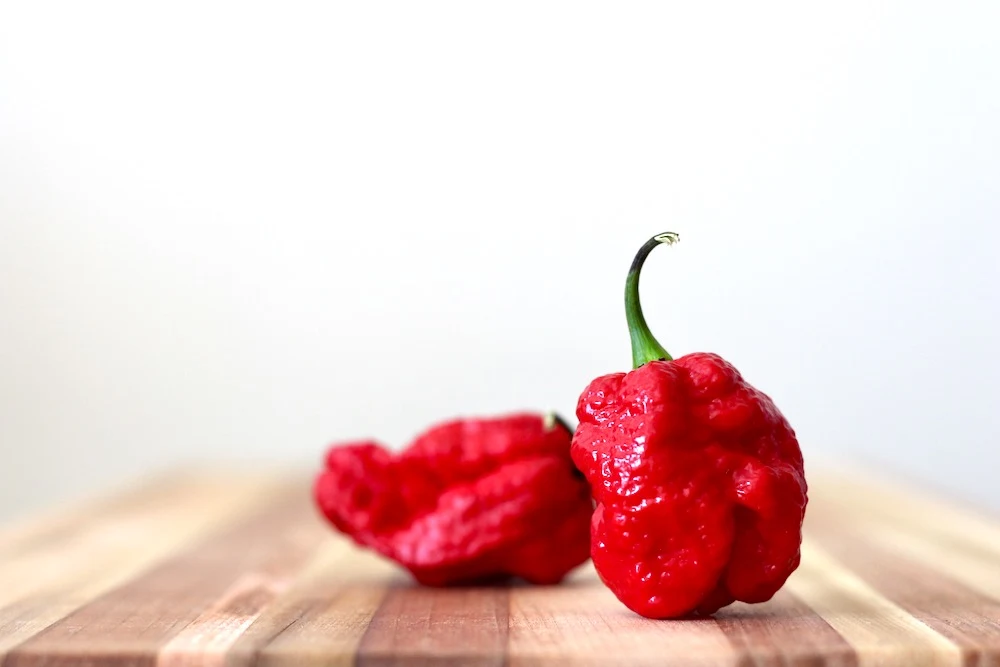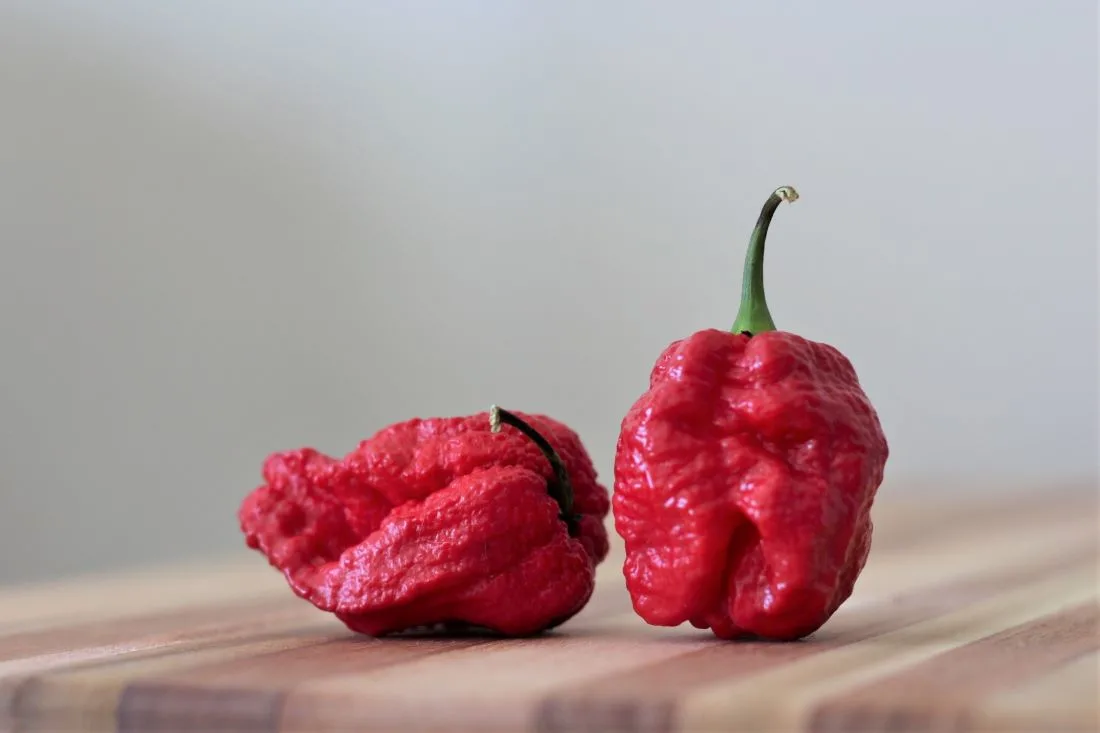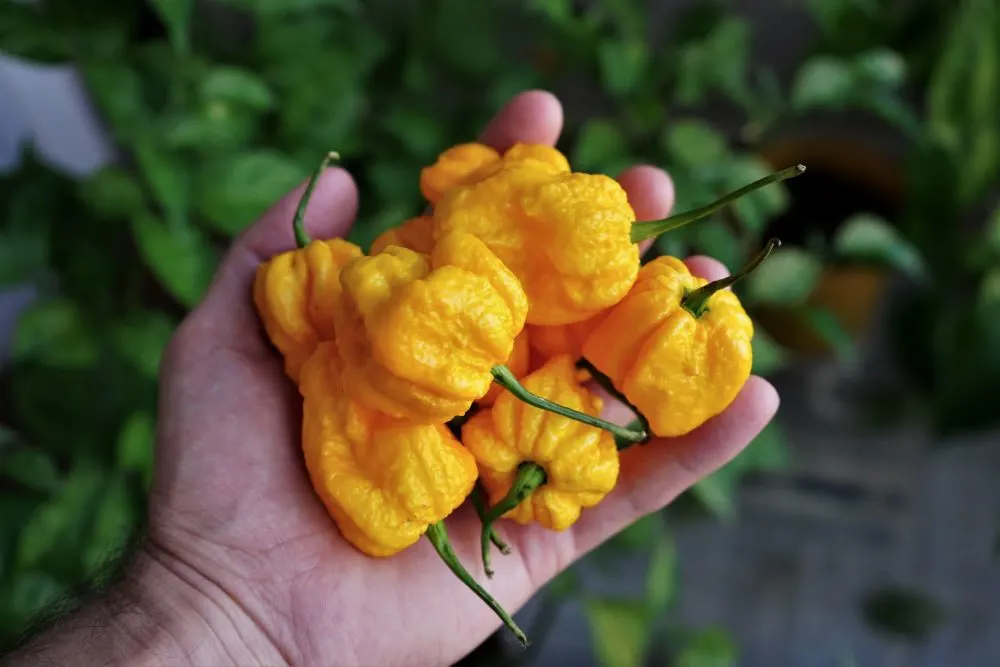In 2008, David Cappiello (known as Cappy on TheHotPepper forum) shared a unique variant of a 7 pot pepper plant. The skin of his peppers was particularly wrinkly, and he posted about it to share with the community.
This went on to become the “brain strain” pepper, and was created through selective plant breeding. This process involves saving seeds from desirable fruits over several generations.
The goal was to select peppers that had a super wrinkly surface, resembling a brain. The original source was the 7 pot pepper from Trinidad, so it is no wonder the pepper got the name 7 pot brain strain.

These peppers are extremely spicy, going up against the very hottest in the world. This is no surprise, since the brain strain shares much of its genetics with the former world record holder, the Trinidad moruga scorpion.
In this article, I’ll go over the basics about the 7 pot brain strain pepper, including its origins, Scoville heat rating, flavor, and more. Let’s get started!
7 Pot Brain Strain Origins
David Cappeillo, known informally as ‘Cappy’ on The Hot Pepper forum, used selective breeding to develop the brain strain pepper variety. The original pepper variety he used was the Trinidad 7 pot or 7 pod pepper, a famous landrace from the Caribbean.
Selective breeding is an age-old technique used for improving crops. The process is quite simple and differs from manually cross breeding peppers.
Basically, plants are grown, and only the ideal fruits are selected for seed saving. In other words, the peppers that have the desired characteristics are chosen, and then used to grow the next generation of plants.
Over many growing seasons, natural genetic selection will cause the new characteristics to become more stable. This process is less scientific than manual cross breeding, which involves emasculation of flowers and cross-pollination between two plants.
The original plant came from seeds from Trinidad, where many of the hottest naturally-occuring pepper varieties are from. Trinidad 7 pot peppers also helped to develop the 7 pot Primo and the Carolina reaper.
7 Pot Brain Strain Appearance
All 7 pot peppers have a sinister appearance, but the goal when creating the brain strain was to take it a step further. Some peppers have more wrinkles than others, but the brain strain is nothing but bumps!
This pepper immediately brings to mind an image of the human brain, hence the name. It also resembles melting lava, which perfectly reflects the blazing heat it contains.
The shape is very similar to that of the moruga scorpion, though it does not have a pronounced tail. Instead, the bottom end is usually flat, and any tail that is present is recessed into the fruit.

The bizarre, melting, bumpy look is attractive to chiliheads and Pepper Geeks. The more strange, the better!
There are newer varieties of peppers that have been bred with the brain strain, including some of our favorite superhots. These include the scotch brains, yellow nagabrains, and more.

7 Pot Brain Strain Scoville Scale
It will come as no surprise that the brain strain pepper has an extremely high heat level. Its origins are from one of the world’s hottest peppers, and it maintained most of that heat!
In short, the 7 pot brain strain pepper comes in at around 1,200,000 SHUs on the Scoville Scale. This puts the brain strain above the bhut jolokia (ghost pepper) by about 200,000 SHUs!
How the brain strain burned me (a story)
The first superhot pepper I ever tasted was a tiny sliver of a brain strain pod. It was a hot summer day, and we were at Chilifest in Sunderland, MA. They had samples of all sorts of unique peppers, so I naturally reached for one of the superhot varieties.
“Brain strain, hah! What a great name, I’ll try a nibble,” said my uninformed, naïve self. “It’s only about as big as a peanut…”
5 minutes later, and I was in complete agony. Thankfully, I was somehow enjoying the experience. Nothing would quell the fire (not even ice cream), and my heat tolerance was laughably low, so I just rode out the pain.
After about 15 minutes, I was graced with a sense of euphoria like I had never experienced – the endorphin rush!
I was shocked by how potent a tiny piece of pepper could be, even without any of the placenta! Brain strain peppers are serious hot peppers that will give even the biggest hot sauce junkies a run for their money.
7 Pot Brain Strain Flavor
In the short time I had to register a flavor profile, I remember the Brain Strain pepper being pretty tasty. It was fruity with a punchy, almost smoky flavor.
I remember saying something like, “Why don’t they sell these in stores, they’re tasty!” That, of course, was before I got slapped in the face by the heat.
They really are delicious, and I have said this about other Caribbean pepper varieties. Scotch bonnets, scorpion peppers, goat peppers, and more. They have a tropical, fruit-like taste that is perfectly suited for making tasty hot sauces and fruity salsas.
Growing the 7 Pot Brain Strain Pepper
If you are interested in tasting these peppers, you will probably have to grow them yourself. There are places online where you can order fresh pods, but they are usually only available during peak harvest season.
To grow brain strain peppers, follow our superhot pepper grow guide here.
Growing superhots is only slightly different from growing any other pepper variety. The main difference is the time to harvest. Brain strain peppers may take 120 days or longer after transplanting outdoors to produce ripe peppers.
As with all peppers, they like very warm temperatures, full-sun, good drainage, and plenty of nitrogen during early plant growth. They are perfect for growing in pots, or in a raised garden bed.
The plants can become huge, easily reaching 5′ or bigger in a single season (under ideal growing conditions). Be sure you have the space for a large, bushy plant!
I hope this article helped you learn a bit more about the 7 Pot Brain Strain pepper. It has become a cult classic in the lineup of superhot pepper varieties, and for good reason. Share any experience you’ve had with this pepper variety below!


Mark
Saturday 16th of September 2023
I'm growing a 7pot (along with serveral other super hot varieties) here in Spain. What I noticed with the 7pot all the flower buds developed well, but then they yellowed and fell off. A second set of buds then emerged and these are now growing into lovely looking fruit. Is this normal as it's not happened with any of the others I'm cultivating.
Olly
Tuesday 17th of August 2021
Hi Oli,
sounds like non-varietal seed, where do the seeds come from?
Oli
Friday 19th of March 2021
The first peppers I planted were Habanero and at the end of the season there were always several peppers on them so I kept them indoors during the winter, now they are 3 years old and still doing well, except that last year the shape of some of its peppers started to change from Habanero's standard shape, they went into a bell shape ... do you know what that could come from?
peppergeek
Friday 19th of March 2021
Never heard of anything like this happening, would love to see pictures.